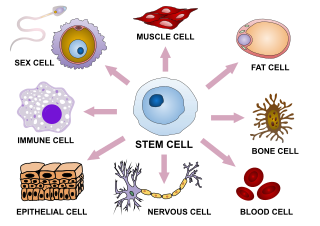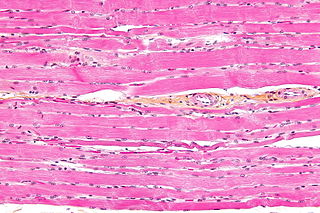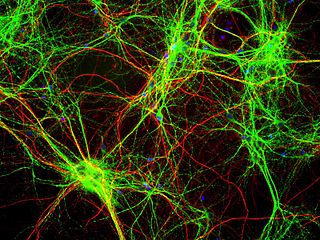See also
- Stable cells, which only multiply when receiving external stimulus to do so [4]
- Permanent cells, which don't have the ability to multiply [5]
In cellular biology, labile cells are cells that continuously multiply and divide throughout life . [1] [2] Labile cells replace the cells that are lost from the body. [1] When injured, labile cells are repaired rapidly due to an aggressive TR response. [1] This continual division of labile cells allows them to reproduce new stem cells and replace functional cells that are lost in the body. [1] Functional cells may be lost through necrosis, which is the premature death of cells caused by environmental disturbances, such as diseases or injuries. [3] Functional cells may also need to be replaced after undergoing apoptosis, which is the programmed death of cells that occurs normally as part of an organism's development. [3] Labile cells continually regenerate by undergoing mitosis and are one of three types of cells that are involved in cell division, classified by their regenerative capacity. [ citation needed ] The other two cell types include stable cells and permanent cells. Each of these three cell types respond to injuries to their corresponding tissues differently. Stable cells, unlike labile cells, are typically not dividing and only do so when an injury occurs. [4] Permanent cells are not capable of division after maturing. [5]
Some examples of labile cells, which act as stem cells, include skin cells, such as the epidermis , the epithelia of ducts, hematopoietic stem cells, [1] cells within the gastrointestinal tract, and some cells found within bone marrow. [6]
Labile cells exhibit a very short G1 phase and never enter G0 phase (the resting phase), as they are continually proliferating throughout their life. [6]
Cells that are constantly dividing have a higher risk of dividing uncontrollably and becoming malignant, or cancerous. [7] Muscle tissue does not consist of constantly dividing cells, which is likely why cancer of the muscle is not nearly as common as, for example, cancer of the skin. [8]
In addition, cytotoxic drugs used in chemotherapy target dividing cells and inhibit their proliferation. [9] The cytotoxic drugs aim to target the dividing cells which are malignant in the body; however, these drugs target all dividing cells and are not capable of only selecting the cancerous ones. [10] Healthy cells, that are normally dividing in the body, are targeted and affected as well. [10] For this reason, adverse effects are often produced from chemotherapy. [11] The labile cells within epithelial tissue and bone marrow, for example, may be targeted, resulting in possible hair loss or bone marrow suppression. [ citation needed ]

Necrosis is a form of cell injury which results in the premature death of cells in living tissue by autolysis. The term "necrosis" came about in the mid-19th century and is commonly attributed to German pathologist Rudolf Virchow in, who is often regarded as one of the founders of modern pathology. Necrosis is caused by factors external to the cell or tissue, such as infection, or trauma which result in the unregulated digestion of cell components. In contrast, apoptosis is a naturally occurring programmed and targeted cause of cellular death. While apoptosis often provides beneficial effects to the organism, necrosis is almost always detrimental and can be fatal.

Cellular differentiation is the process in which a stem cell changes from one type to a differentiated one. Usually, the cell changes to a more specialized type. Differentiation happens multiple times during the development of a multicellular organism as it changes from a simple zygote to a complex system of tissues and cell types. Differentiation continues in adulthood as adult stem cells divide and create fully differentiated daughter cells during tissue repair and during normal cell turnover. Some differentiation occurs in response to antigen exposure. Differentiation dramatically changes a cell's size, shape, membrane potential, metabolic activity, and responsiveness to signals. These changes are largely due to highly controlled modifications in gene expression and are the study of epigenetics. With a few exceptions, cellular differentiation almost never involves a change in the DNA sequence itself. However, metabolic composition does get altered quite dramatically where stem cells are characterized by abundant metabolites with highly unsaturated structures whose levels decrease upon differentiation. Thus, different cells can have very different physical characteristics despite having the same genome.

Bone marrow is a semi-solid tissue found within the spongy portions of bones. In birds and mammals, bone marrow is the primary site of new blood cell production. It is composed of hematopoietic cells, marrow adipose tissue, and supportive stromal cells. In adult humans, bone marrow is primarily located in the ribs, vertebrae, sternum, and bones of the pelvis. Bone marrow comprises approximately 5% of total body mass in healthy adult humans, such that a man weighing 73 kg (161 lbs) will have around 3.7 kg (8 lbs) of bone marrow.

Telomerase, also called terminal transferase, is a ribonucleoprotein that adds a species-dependent telomere repeat sequence to the 3' end of telomeres. A telomere is a region of repetitive sequences at each end of the chromosomes of most eukaryotes. Telomeres protect the end of the chromosome from DNA damage or from fusion with neighbouring chromosomes. The fruit fly Drosophila melanogaster lacks telomerase, but instead uses retrotransposons to maintain telomeres.
Cytotoxicity is the quality of being toxic to cells. Examples of toxic agents are an immune cell or some types of venom, e.g. from the puff adder or brown recluse spider.

Malignancy is the tendency of a medical condition to become progressively worse; the term is most familiar as a characterization of cancer.

Striated muscle tissue is a muscle tissue that features repeating functional units called sarcomeres. The presence of sarcomeres manifests as a series of bands visible along the muscle fibers, which is responsible for the striated appearance observed in microscopic images of this tissue. There are two types of striated muscle:
In the field of genetics, a suicide gene is a gene that will cause a cell to kill itself through the process of apoptosis. Activation of a suicide gene can cause death through a variety of pathways, but one important cellular "switch" to induce apoptosis is the p53 protein. Stimulation or introduction of suicide genes is a potential way of treating cancer or other proliferative diseases.
Coagulative necrosis is a type of accidental cell death typically caused by ischemia or infarction. In coagulative necrosis, the architectures of dead tissue are preserved for at least a couple of days. It is believed that the injury denatures structural proteins as well as lysosomal enzymes, thus blocking the proteolysis of the damaged cells. The lack of lysosomal enzymes allows it to maintain a "coagulated" morphology for some time. Like most types of necrosis, if enough viable cells are present around the affected area, regeneration will usually occur. Coagulative necrosis occurs in most bodily organs, excluding the brain. Different diseases are associated with coagulative necrosis, including acute tubular necrosis and acute myocardial infarction.

Cell therapy is a therapy in which viable cells are injected, grafted or implanted into a patient in order to effectuate a medicinal effect, for example, by transplanting T-cells capable of fighting cancer cells via cell-mediated immunity in the course of immunotherapy, or grafting stem cells to regenerate diseased tissues.

Adult stem cells are undifferentiated cells, found throughout the body after development, that multiply by cell division to replenish dying cells and regenerate damaged tissues. Also known as somatic stem cells, they can be found in juvenile, adult animals, and humans, unlike embryonic stem cells.
Stem-cell therapy is the use of stem cells to treat or prevent a disease or condition. As of 2016, the only established therapy using stem cells is hematopoietic stem cell transplantation. This usually takes the form of a bone-marrow transplantation, but the cells can also be derived from umbilical cord blood. Research is underway to develop various sources for stem cells as well as to apply stem-cell treatments for neurodegenerative diseases and conditions such as diabetes and heart disease.
Minimal residual disease (MRD) is the name given to small numbers of leukaemic cells that remain in the person during treatment, or after treatment when the patient is in remission. It is the major cause of relapse in cancer and leukemia. Up until a decade ago, none of the tests used to assess or detect cancer were sensitive enough to detect MRD. Now, however, very sensitive molecular biology tests are available, based on DNA, RNA or proteins. These can measure minute levels of cancer cells in tissue samples, sometimes as low as one cancer cell in a million normal cells.

White blood cells, also called leukocytes or immune cells also called immunocytes, are cells of the immune system that are involved in protecting the body against both infectious disease and foreign invaders. White blood cells include three main subtypes; granulocytes, lymphocytes and monocytes.
Gene expression profiling has revealed that diffuse large B-cell lymphoma (DLBCL) is composed of at least 3 different sub-groups, each having distinct oncogenic mechanisms that respond to therapies in different ways. Germinal Center B-Cell like (GCB) DLBCLs appear to arise from normal germinal center B cells, while Activated B-cell like (ABC) DLBCLs are thought to arise from postgerminal center B cells that are arrested during plasmacytic differentiation. The differences in gene expression between GCB DLBCL and ABC DLBCL are as vast as the differences between distinct types of leukemia, but these conditions have historically been grouped together and treated as the same disease.

Mesenchymal stem cells (MSCs) also known as mesenchymal stromal cells or medicinal signaling cells are multipotent stromal cells that can differentiate into a variety of cell types, including osteoblasts, chondrocytes, myocytes and adipocytes.
Adult mesenchymal stem cells are being used by researchers in the fields of regenerative medicine and tissue engineering to artificially reconstruct human tissue which has been previously damaged. Mesenchymal stem cells are able to differentiate, or mature from a less specialized cell to a more specialized cell type, to replace damaged tissues in various organs.
Molecular oncology is an interdisciplinary medical specialty at the interface of medicinal chemistry and oncology that refers to the investigation of the chemistry of cancer and tumors at the molecular scale. Also the development and application of molecularly targeted therapies.

Arabinopyranosyl-N-methyl-N-nitrosourea, also known as Aranose (Араноза) is a cytostatic anticancer chemotherapeutic drug of an alkylating type. Chemically it is a nitrosourea derivative. It was developed in the Soviet Union in the 1970s. It was claimed by its developers that its advantages over other nitrosoureas are a relatively low hematological toxicity and a wider therapeutic index, which allows for its outpatient administration.

Permanent cells are cells that are incapable of regeneration. These cells are considered to be terminally differentiated and non-proliferative in postnatal life. This includes neurons, heart cells, skeletal muscle cells and red blood cells. Although these cells are considered permanent in that they neither reproduce nor transform into other cells, this does not mean that the body cannot create new versions of these cells. For instance, structures in the bone marrow produce new red blood cells constantly, while skeletal muscle damage can be repaired by underlying satellite cells, which fuse to become a new skeletal muscle cell.